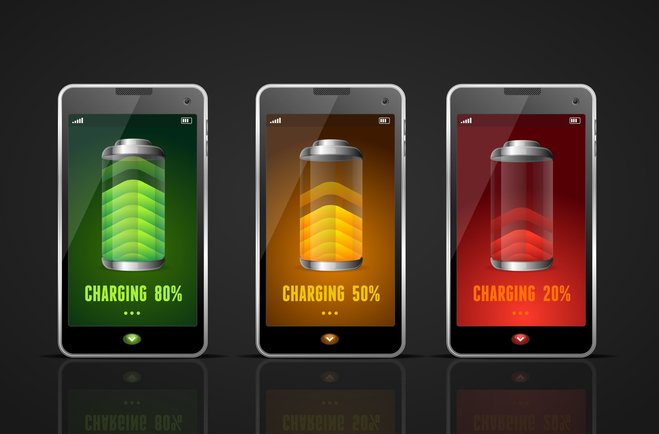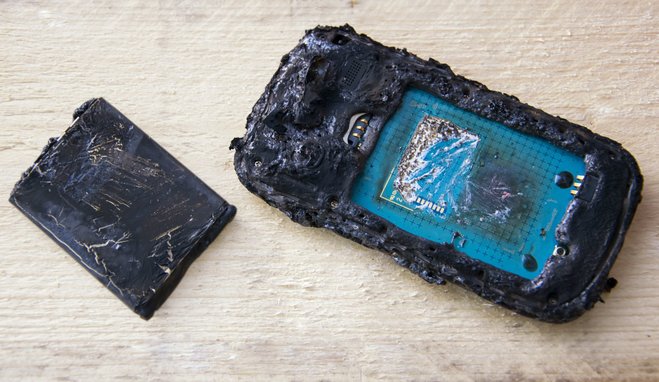We're more or less all familiar with rechargeable batteries (because we use them) yet there are still many mysteries surrounding them. Add to that reports of houses that burned down because of smartphones or e-bikes that spontaneously burst into flames and you may start to feel a little uneasy about this technology. What kind of witchcraft is it that powers so many of our devices? Why do some of these batteries suddenly burst into flames and how can we prolong their lifespans?

The problem
During the initial stages of product development, companies usually face a big technical hurdle, especially with smartphones: they're supposed to be ultra light and ultra thin yet immensely powerful. Devices that stray from this mantra are quickly discarded as old-fashioned, inelegant and clunky. Samsungs's Galaxy Note 7 was certainly an elegant product with a thickness of 7.9 mm and a weight of 169 g. As always, one of the development goals was to create a powerful device with a huge screen and long-lasting battery life. Today, almost all mobile devices come with rechargeable Lithium-ion (Li-on) batteries. No other technology currently stores as much energy and offers as many recharging cycles in such a very compact, space-saving housing. Unfortunately, Lithium(-oxide) is also highly reactive, inflammable and toxic. It takes immense precision to create batteries with high energy density with each cell containing as many thin and densely packed layers of this substance as possible. There's always a risk of fire or explosions caused by production errors as well as overheating, damaged or contaminated materials.
Prevalence
Samsung's Galaxy Note 7 was the most prominent problem child but definitely not the only one. Roughly 0.1% of all Note 7 devices were affected and this posed an unacceptable risk in view of 2.5 million sold devices. Still, other devices also have a tendency to burst into flames, just less frequently. This is obviously not a new issue nor does it only affect Samsung devices even though the media made it appear that way. 10 years ago, there were already cases of Sony laptops happily smoldering away with 8 million devices being recalled and refitted with new batteries. Current iPhone models occasionally also make for a nice bonfire but not often enough to make the headlines or trigger a product recall. Do you own e-bikes, e-cigarettes, notebooks or the latest toys? If so, you're already surrounded by Li-on batteries that may exhibit similar unfavorable behavior.

What can you do about it?
In the case of faulty design as exhibited by the Note 7, nothing, it's that simple. But there are ways to take better care of your batteries. Avoid extreme temperatures, neither searing heat nor freezing cold will benefit your devices. Don't leave your e-bike in your unheated garage in the deepest winter or the next recharging cycle may be the last due to deep discharging. Likewise, leaving your smartphone in the car in the heat of the summer is a bad idea. Moisture, as you might have guessed, is also detrimental to your device because of the risk of shorted circuits. As for chargers, you may simply want to go with the manufacturers' recommendations to avoid overcharging which poses a severe health hazard. Don't use accidentally dropped batteries as their internal structure may have become compromised (especially with hard surfaces like concrete floors). This can also be caused by too much pressure, e.g. with devices you keep in the pockets of your pants, as demonstrated in many scary online videos. B attery-powered devices that are continuously connected to a power supply (like many laptop computers) should regularly be run on batteries alone, companies like Apple also recommend sporadic discharging to keep batteries healthy.
Nice to knows
Modern rechargeable batteries should easily handle between 700 and 1000 charge cycles before their performance degrades. Compared to earlier designs, today's models have significantly longer lifespans and it is not normal for these batteries to break down after just a couple of charges, even though some sales personnel may try to convince you otherwise. Partially charged batteries can be used right away, you don't have to fully charge them first. Fast chargers are a subject of debate as they may lead to reduced lifespans. Whether this effect is noticeable during normal use is another story. Most chargers already feature smart sensors and only provide as much power as each battery can handle. Once your batteries are charged, unplug them. This prevents continuous charging / discharging at maximum power levels, reduces wear and tear and saves energy. As it is next to impossible to put out fires caused by burning electronic devices, you should simply place them in a container, e.g. a pot, and take them outside - the fumes are toxic after all.
 Something went wrong...
Something went wrong...
Common misconceptions
Many current tips are rooted in beliefs that stem from outdated battery technologies and are no longer valid. Unlike older Nickel-metal hydride batteries, Li-on batteries cannot be "trained". While it is true that devices may report seemingly better figures for their batteries once they've been recharged a couple of times, this is due to more accurate calibration, not enhanced performance. You should avoid complete discharges (a hot tip back in the days) since they will lead to reduced storage capacities and lifespans. Most devices shut down automatically before this point is reached anyway, so, if you find that your smartphone has completely powered down by itself, don't be alarmed, it'll come back on eventually.
The future
Modern smartphones have pushed Li-on technology to its limits. When products become more dangerous because of shorter development cycles, superficial testing and obsessions with super-thin designs, we need a change in thinking! As customers, we also bear a responsibility: will a few more grams really ruin your back during lifting? Do a few more millimeters render devices instantly bulky? Manufacturers will have to decide whether they'll continue to follow every new trend even if it makes their products more hazardous. Are tightly screwed or glued in batteries really necessary? Shouldn't parts that are potentially dangerous and wear out over time be accessible and replaceable? I for one follow the development of this technology very closely and with great interest. Li-on batteries are far from being the ultimate in portable power solutions, there's a pressing need for further research and better products.
Author's side note: Dear tech zealots, chemists, physicists and masters of engineering, I've written this text to the best of my abilities. This text doesn't target specialists so go easy on me. Whenever I encountered various or divergent facts and tips, I either went with the mainstream view or picked those that seemed most plausible to me.




I must say some gadget manufacturers have perfected their rechargeable battery technology over the years. I use an iPod 4th generation music player from Apple for over 6 years now and made over 2000 recharge cycles still working as if it were a new one. Percentages drop a little faster to 90 but after that it is business as usual. This can only be accomplished with high tech hardware and sophisticated software tuning. It never runs hot or depletes when stored for a long period being switched off. You tell me why others can't do the same?
I agree that the emphasis on thinness is misplaced.
I would rather have a thicker device with a user-replaceable battery than a super-thin device with a non-replaceable battery. I don't need the latest and greatest.
Just come across this last week Sven, thought it might interest you.
http://www.popularmechanics.com/science/energy/a25536/inventor-lithium-ion-battery-invented-another-battery/
Thank you!
15 years ago I purchased a calculator for my office desk. It has one small solar cell to keep it operating. Today it's still going strong.
I have often wondered why the cell phone manufacturers stay away from a solar cell. The tiny solar cell would keep the phone from dying. It would also work in conjunction with the rechargeable Lithium-ion without the need for cables.
It elementary Sven.
Thanks for the article, Sven. As usual, your articles are very relevant.
It's been coming along slowly since the mini-explosion onto the scientific scene 5+ years ago, but we can have hope for better batteries in the near future with graphene. Here is a helpful link: http://www.graphene-info.com/graphene-batteries
Along with this is the cooling capacity of graphene for small devices such as cell phones, computers, etc. Here is a helpful link: https://phys.org/news/2017-03-graphene-cool-smartphone-electronics-chips.html
Perhaps reaching the limits of lithium ion battery building will force the issue on speedier development of graphene into the marketplace.
Thanks Sven.another good article well written. love your blogs, keep it up.
Well written Sven,
A battery, a container consisting of one or more cells, in which chemical energy is converted into electricity and used as a source of power.
Can be as dangerous as:-
A battery, a fortified emplacement for heavy guns.
External batteries?
They are becoming cheaper and I am seeing more and more people with them.
While inconvenient it could be the next step.
If it decides to fry you just yank it off the cord and put it in a pot or whatever.
End result, you buy a new battery pack, not a new device.
A battery pack can be kept in your pocket or purse and the cord runs from it to the device.
Would that be any different than the headphones you have running from your device to your ears?
I recall recently a passenger on a flight who went to sleep and woke up with her wireless headset burning her face so wired headsets may become more popular as well. LOL.
Very interesting article. Well written - and timely. I don't know whether or not to leave my laptop permanently on charge or, as one battery supplier suggested: to fully charge it before first use, use it on Battery until fully discharged twice, then . . . ? what? But I came across a timely article on YouTube regarding battery research in Australia - this must be watched to the end, for there is a hugely important development afoot.
See: https://www.youtube.com/watch?v=TANINuODTTo
Michael. UK
Sven: Assuming you are not a native English speaker this article is clear, concise, and to the point. So bravoo to you, not only for the article but for being able to provide it in my language, probably more clearly than a native speaker. I'd claim English as my native language but George Bernard Shaw would probably disagree.
I wouldn’t want to claim someone else’s glory. :) I write these articles (and this response) in German which is my native tongue. I then pass them on to my translator, Manuel Verlaat, who prepares and translates everything for the english blog.
Yes, a farm manager once asked me about his laptop because he had taken it to use on battery and it lasted just three minutes. I asked him if he had ever used it on battery before and he replied he had always left it plugged in (two years). The result was that the battery had lost the capacity to keep a charge.
Thanks,very well written.
Thanks Sven. A nicely balanced and understandable article.
That's really useful information, Sven, and dispels one major misunderstanding that I have of li-on batteries. I had always thought that they could be left connected to a charger indefinitely without deterioration - so my laptop is almost always connected and fully charged.
In future I shall regularly disconnect it and run it on battery alone, until it's discharged.
Thank you Sven for a very informative article.
Keep them coming.
Excellent article and timely. I have a Samsung S5 which is good from this respect, recently fitted new genuine battery, probably well over 1000 charges for the old one. Q1 I have been getting ads, ignored, for an App that causes faster charging. Is there a danger and should I keep ignoring this?
Secondly, yesterdays local paper carried a story about a local teenager with a burnt Samsung S4 phone and a hole in her dress, her brother recently bought her a new battery, on line, possibly non genuine. Is there a danger there?
Hi Sven. For a non-physical chemist, you have done a remarkable job. The care and feeding of these animals is quite a minefield [on which I once wrote a paper]. All that it occurs to me to add - for general info, not as correction - is that it's not the field of the lithium-ion 'battery', but 'batteries', as there are a range of chemistries involved giving different characteristics.
For example, for emergency medical equipment life span can be longer, as can 'shelf-life' between charges. And even for some everyday user devices, recharges of up to 5000 times are possible.
But these comments are just examples of possible footnotes - you covered the subject well, and the info is very timely. Research into battery technology is a major and challenging field.
Very well written.
Great subject, great read, food for thought and taking great care with so many appliance all requiring their own product applicable charger.
It will never happen, but it would be nice to have all batteries capable of accepting one charging device.